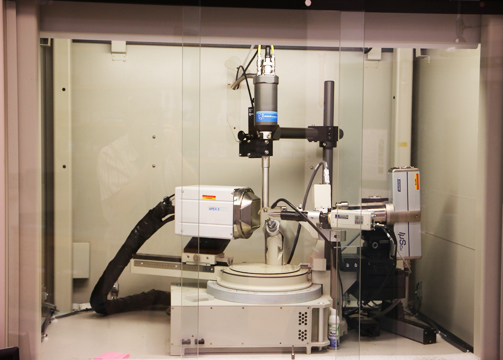
As a result, the mechanism underlying the glassy thermal conductivity of single crystals remains unclear. Further, direct detection of tunneling of heavy structural atoms is generally not possible with scattering methods as the tunneling splitting energies are expected to be sub GHz 34, which is too low to affect thermal conduction except at temperatures less than around 1 K. For instance, while early works on clathrates hypothesized that two-level systems were responsible 29, 30, later works suggested that charge carrier scattering could play a role 33 as the samples were electrically conducting. However, unambiguously identifying the origin of the glassy trend has proved challenging. The glassy thermal conductivity of clathrates, in particular, have been extensively investigated 30, 31, 32. Examples include NaNbO3 21 with a low-symmetry monoclinic or orthorhombic crystal structure at room temperature 25, orthorhombic CsBiNb2O7 with 22 atoms per primitive cell 26, polydiacetylene single crystals 27, Yb-based zintls 28, and clathrates 5, 6, 29. While a material with a complex or low-symmetry crystal structure does not necessarily possess a glassy thermal conductivity, most materials exhibiting the trend are structurally complex. Only a few compounds have been reported to deviate from this trend. Within the perovskite material family, the thermal conductivity varies from 1 to 20 W m −1 K −1 for the simplest ABO 3-type perovskite oxides 19, 20, 21 and chalcogenides 22, and <1 W m −1 K −1 for organic–inorganic hybrid perovskites 23 and inorganic halides 24, although all of these materials follow the crystalline trend of thermal conductivity with temperature. Such homogeneous single crystals with low defect concentrations usually exhibit the familiar trend of decreasing thermal conductivity with increasing temperature above the Debye temperature 18.
BRUKER APEX 3 SINGLE CRYSTAL VIDEO WINDOW FREE
Crystalline materials that exhibit intrinsically low thermal conductivity typically possess large anharmonic force constants, as in SnSe 16 and Tl 3VSe 4 4 a complex crystal structure leading to a large phonon scattering phase space 7, 17 or a naturally occurring inhomogeneous nanoscale structure, as in AgSbTe 2 2, otherwise remaining free of structural defects. This strategy has been demonstrated in diverse classes of materials including multilayers 10, 11, polycrystalline semiconductors 12, 13, and solids containing nanoprecipitates 14, 15, among many others. Low thermal conductivity crystals have been extensively researched for applications such as thermoelectrics 1, 2, 3, 4, 5, 6 and are typically realized by introducing crystalline defects that scatter phonons 7, 8, 9. While atomic tunneling has been invoked to explain the low-temperature thermal conductivity of solids for decades, our study establishes the presence of sub-THz frequency tunneling systems even in high-quality, electrically insulating single crystals, leading to anomalous transport properties well above cryogenic temperatures. A two-level atomic tunneling system exists in a shallow double-well potential of the Ti atom and is of sufficiently high frequency to scatter heat-carrying phonons up to room temperature. Elastic and inelastic scattering measurements reveal the quantum mechanical origin of this unusual trend. Here, we report the observation of ultralow and glass-like thermal conductivity in a hexagonal perovskite chalcogenide single crystal, BaTiS 3, despite its highly symmetric and simple primitive cell. However, this behavior is rare, and its microscopic origin remains unclear. Defect-free crystals that exhibit the glassy trend of low thermal conductivity with a monotonic increase with temperature are desirable because they are intrinsically thermally insulating while retaining useful properties of perfect crystals.

In most crystals, the competition of phonon scattering by anharmonic interactions and crystalline imperfections leads to a non-monotonic trend of thermal conductivity with temperature. Nature Communications volume 11, Article number: 6039 ( 2020)Ĭrystalline solids exhibiting glass-like thermal conductivity have attracted substantial attention both for fundamental interest and applications such as thermoelectrics.

High frequency atomic tunneling yields ultralow and glass-like thermal conductivity in chalcogenide single crystals


 0 kommentar(er)
0 kommentar(er)
